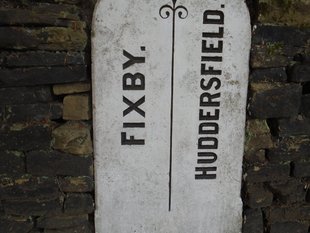
Several months ago, we received an interesting donation here at Local Studies. We were given several theatre programmes and also a bill of sale pertaining to a steam ship by the name of Beryl.
A one sixty fourth share in Beryl (ships have been sold in sixty-four shares since the Merchant Shipping Act of 1854) was to be sold by a Mr William Tulley of Hull to a Mr George Henry Radcliffe of Halifax, a Hairdresser. We are without fail curious here in the basement and automatically we wondered why a hairdresser from Halifax would be buying shares in a ship.
George Henry Radcliffe 1836-1897 was born in Halifax, West Yorkshire, the son of a Hairdresser. There is no record of his marriage but by 1871 he is living with his wife Ann and 4 year old daughter also named Ann. Around 1865 he had established business as a practical hair cutter and perfumer at 18 Crown Street, Halifax. The company also had a laboratory at Gill’s Court, Halifax.
Beryl was built by Matthew Pearse and Co., Stockton-on-Tees in 1880 and first owned by W. Tulley & Co., Hull. She was launched on the 11th of February 1880. Beryl was an Iron Screw Steamer and used for general cargo.
A screw steamer or screw steamship (abbreviated "SS") is an antiquated term for a steamship or steamboat powered by a steam engine, using one or more propellers (also known as screws) to navigate through the water. This type of vessel was also referred to as an "iron screw steam ship."
In the 19th century, this term was typically used to differentiate it from the paddle steamer, an earlier type of steamship that was mostly, though not completely, replaced by the screw steamer.
Many renowned ships were screw steamers, including the RMS Titanic and RMS Lusitania.

Beryl had an interesting ‘life,’ by 1900 she had taken a trip across Europe and was now owned by H. M. Gehrckens, Hamburg. She was renamed Umea and once sold to an Italian company in 1912 renamed once again to Bengasi. By the 1920’s she was a French ship, and she was reported broken up there in 1929.
But why would Mr Radcliffe be buying shares in a ship and why would the bill of sale end up here in Halifax? That unfortunately is a mystery, one can only assume that it was merely seen as a worthwhile investment as ship shares were a popular investment in the Victorian era. But the research did lead us down the path of George Henry Radcliffe’s sudden death in June 1897.
Mr Radcliffe along with his wife Ann were out walking on Commercial Street in Halifax when a 29lb ornamental ball fell from a building above and stuck him. Though he survived the initial blow, he died a few days later of his injuries.

Mr Radcliffe appears to have been a prominent and popular tradesman in Halifax and his funeral onwas well attended by the great and the good of the town. The funeral procession was led by many from the local Rifle Volunteers as Henry Radcliffe had been a member of the corps for twenty years. Also in attendance were many freemasons from Mr Radcliffe’s lodge.
The bill of sale has now been passed on to West Yorkshire Archives and can be found in their Calderdale office. We also have many interesting donations you can view in the Local Studies Library, and we always welcome donations of locally relevant ephemera. Have a look through our catalogue for items of interest or just come in and delve into a random pamphlet box of history.
https://calderdale.spydus.co.uk/cgi-bin/spydus.exe/MSGTRN/OPAC/HOME
References and further reading:
https://www.teesbuiltships.co.uk/view.php?
Halifax Evening Courier - Saturday 12 June 1897




![BILL OF SALE FOR SHARES IN THE SHIP 'BERYL', RECORDS [WYC:1992]](https://static.wixstatic.com/media/02c737_0a446f4e54864ec49c85d3f788170987~mv2.webp/v1/fill/w_141,h_106,al_c,q_80,usm_0.66_1.00_0.01,blur_2,enc_auto/02c737_0a446f4e54864ec49c85d3f788170987~mv2.webp)





